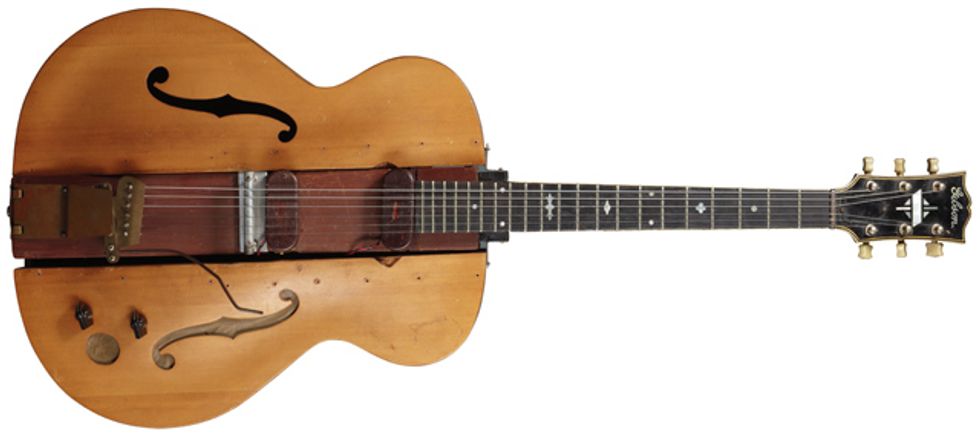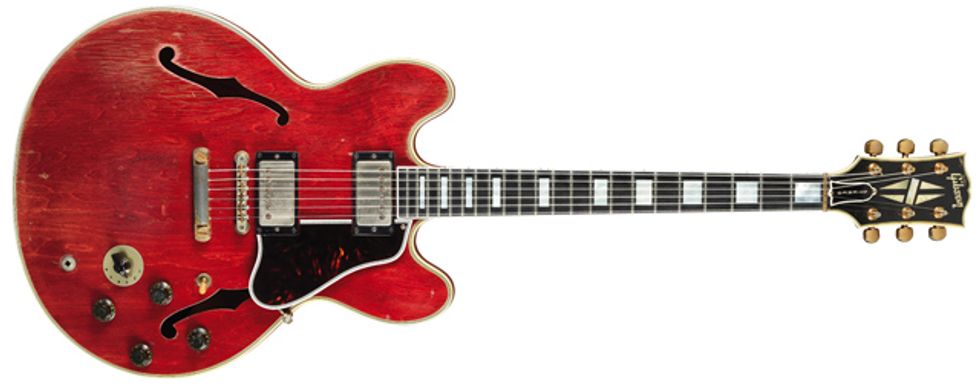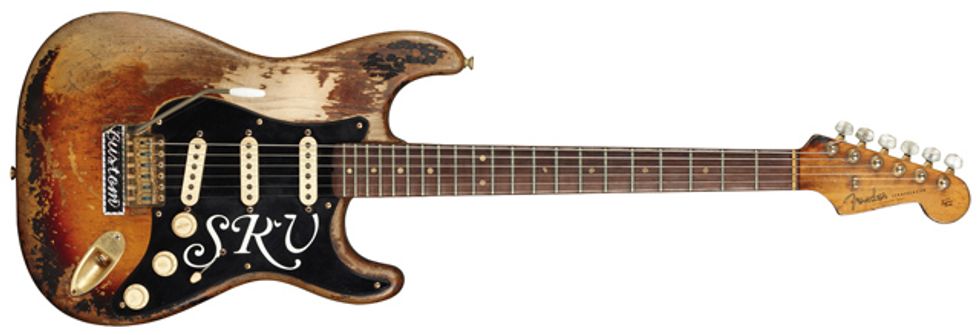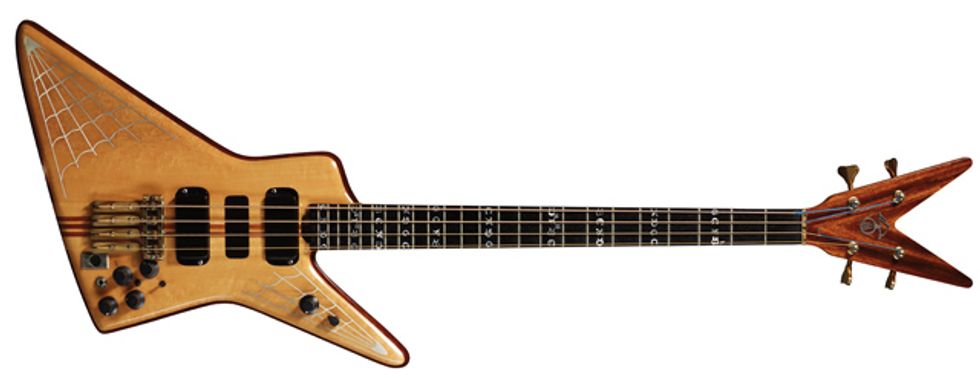An up-close and intimate look at six historic instruments profiled in Epic Ink’s lavi sh new book The Guitar Collection.
It’s not often you hear about a $1500 book filled with 670
huge, luscious images of the most iconic guitars ever—
instruments like Jeff Beck’s 1954 Fender Esquire, Hank
Williams’ 1944 Martin D-28, and Rick Nielsen’s checkered
5-neck Hamer. A truly epic read, The Guitar Collection features
512 pages of quality, 23" x 11.25" paper, weighs 20
pounds, and comes in a custom leather case that would
look at home right next to the resting place for a boutique
solidbody. Epic Ink graciously granted Premier Guitar permission
to reprint the following excerpts of six tantalizing
and historically significant instruments from the new tome.
Enjoy!
Stradivarius, “The Rawlins”
| from the collection of the National Music Museum, the University of South Dakota, Vermillion |
Made in 1700

The most celebrated violin maker of all time, Antonio Stradivari of Cremona, Italy, made at least four guitars. Unlike the violin, which reached its pinnacle of design in Stradivari’s hands, the guitar was only midway through its evolutionary journey in 1700, when this Stradivarius guitar was built.
The Rawlins, named for the benefactors who acquired it for the National Music Museum, has an ancestral relation to the lute that is apparent in this instrument’s courses of paired strings—a configuration that would prevail on the modern mandolin but would disappear on the guitar around 1800. However, the hourglass body shape, with a waist delineating upper and lower bouts, distinguished even the earliest guitars of the mid 1500s from the pear-shaped lute.
Like virtually all Stradivarius violins, this guitar has been modified. The embedded ebony frets are highly suspect in an era when guitars typically had tied-on gut frets, and these frets are not in the correct positions. The scale length of more than 29 inches is so long that gut strings would break before they could be tuned up to standard pitch.
The prominent name and date on the back of the headstock, the too-long scale, and the misplaced frets suggest that this instrument may have been made to showcase Stradivari’s artisanship rather than to be played.
“The Log”
| From the collection of the Country Music Hall of Fame and Museum |
Made circa 1941 and played by Les Paul

By the 1940s, Les Paul was one of the most famous acoustic guitarists in America, but with this homemade guitar, nicknamed the Log, he became one of the earliest—and best-known—proponents of the solidbody electric guitar.
An inveterate tinkerer and experimenter, Paul knew that a thicker guitar top would sustain string vibrations longer and provide a more brilliant tone—two qualities that perfectly suited his lightning-fast playing style. In 1941, he took the concept to the extreme and built this guitar around a 4-inch-by-4-inch slab of pine wood.
The Log looks like a standard hollowbody archtop, and the body wings did in fact come from an Epiphone guitar. The neck has the inlay pattern of the Chicago-based Larson Brothers, with a later headstock overlay from a Gibson. The vibrato and the wood-covered pickups were handmade by Paul.
Paul would start a performance with the sides attached to the center block. Once the audience had accepted the sound of the instrument, he removed the wings to reveal the solid center. Although it was a gimmick, this guitar gave Paul an unforgettable association with the solidbody electric guitar that led to his lucrative endorsement deal with Gibson.
Gibson ES-355 “Lucille”
| From The Collection of Hard Rock International |
Made in 1962 and played by B.B. King

Throughout the 1950s, B.B. King’s Lucille—the name he gave all of his guitars— was a hollowbody Gibson, but at the turn of the decade he switched to Gibson’s innovative new semi-hollowbody designs. He eventually embraced the ES-355 exclusively.
Gibson’s ES-335, ES-345, and ES-355 had identical construction, with a solid block running down the center of the body to minimize feedback. It appears King’s choice of the ES-355 was based entirely on the expensive look of its large pearl block inlays and multi-ply binding. He didn’t use the ES-355’s stereo capability (as indicated by “Stereo” on the truss-rod cover). He turned the “chicken-head” knob of the Vari-Tone control, which provided a progressive filter of midrange tones, to its minimum setting; when he got his own Gibson signature model, he added a “0” position so the control could be bypassed. He removed the original vibrato entirely—the plugged screw holes are still visible in the top—and added a stop-bar tailpiece, which provided more sustain.
The weathered finish and the worn gold plating on the pickup covers and bridge of this, King’s first ES-355, attest to its constant use. King retired this “Lucille” in 1967 and gave it to Chicago bluesman Elvin Bishop, but he has continued to play Gibson ES-355s for the rest of his career.
Fender Stratocaster “Number One”
| From the Collection of Jimmie Vaughan |
Made in 1962 and played by Stevie Ray Vaughan

In 1973, an aspiring blues guitarist named Stevie Ray Vaughan went into the Heart of Texas music store in Austin and bought a used Fender Stratocaster. As the wear and tear on this guitar suggests, its nickname, Number One, is well deserved. As Vaughan became the most famous and influential blues guitarist of his generation, this guitar was truly his favorite.
Vaughan replaced the original three-ply white pickguard with a black unit and added his initials, “SRV,” with stick-on letters. He put more permanent proof of his ownership on the back, carving “SR Vaughan” in the wood. The vibrato bridge is a left-handed gold-plated unit because it was the only one available in the guitar store on the day Vaughan needed a replacement.
As the remnants of finish indicate, this guitar had a standard three-tone sunburst finish. Due to constant use, the fingerboard was planed and refretted a number of times, and eventually Vaughan replaced the neck with one from another of his Strats.
After Vaughan’s death in a helicopter crash following a concert in 1990, his older brother, Jimmie, reinstalled the original neck on Number One. In 2004, Fender honored Vaughan by replicating Number One in a limited run of 100.
Fender Stratocaster
| From The Collection of Experience Music Project |
Made in 1968 and played by Jimi Hendrix at Woodstock

No guitar represents a greater convergence of artist, event, and instrument than this 1968 Fender Stratocaster played by Jimi Hendrix at Woodstock.
Taken alone, the instrument is rather unremarkable. For starters, it was made during CBS’s ownership of Fender, a period of declining quality. It’s a stock right-handed Stratocaster with Olympic White finish. Although the maple fingerboard appears to be integral with the neck, as it was on 1950s Fenders, it is actually separate; the giveaway is on the back of the neck, where there is no evidence of the walnut “skunk stripe” that is present on all Fender one-piece necks. Hendrix played left-handed, but rather than special-ordering a lefty, he simply flipped the guitar over and reversed the strings, so that the heavier bass strings would be on what is normally the treble side.
Although the Strat had some degree of notoriety in rock and roll music, thanks to Buddy Holly and the surf bands, it was overshadowed in the Fender line in the early to mid 1960s by the more expensive Jazzmaster.
The film Woodstock featured Hendrix’s screaming, pyrotechnic version of “The Star-Spangled Banner,” which set the course for the future of rock guitar and instantly raised the Stratocaster to the iconic status that it enjoys today.
Alembic Exploiter Spyder Bass
| From The Collection of Hard Rock International |
Made in 1980 and played by John Entwistle

Alembic was founded in 1969 as an electronics consulting company but quickly gained a reputation for creating high-end basses. Alembic’s active electronics and exotic woods attracted the attention of the Who’s John Entwistle, who ordered the first of many custom Alembics in 1974.
In 1977, Entwistle came up with a design based on the Gibson Futura, a prototype for Gibson’s 1958 Explorer. Entwistle acknowledged the Explorer connection by calling his model the Exploiter. The inlaid sterling-silver spider webs also inspired the name Spyder. Entwistle had a number of basses made with this design. This one, sporting maple and walnut body woods and a zebrawood headstock overlay, was made in 1980, just in time for Entwistle to pose with it for the cover photo of his 1981 solo album, Too Late the Hero.
The five-prong microphone jack (located next to the bridge) provided a direct input to a recording studio board, but it required a transformer for use with a standard bass amplifier. This inconvenience, along with the basses’ instability under the climate variations that are unavoidable on tour, caused Entwistle to abandon Alembics as his main stage basses in 1985. He maintained a close relationship with the company, however, and was working with Alembic on a special edition of the Spyder when he died in 2002.
From Your Site Articles


